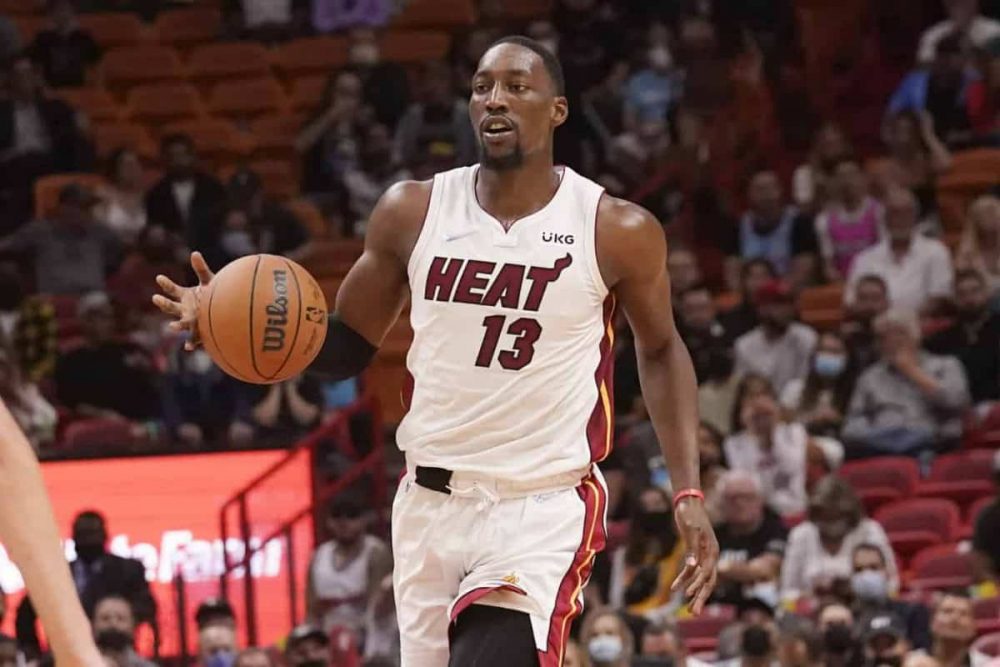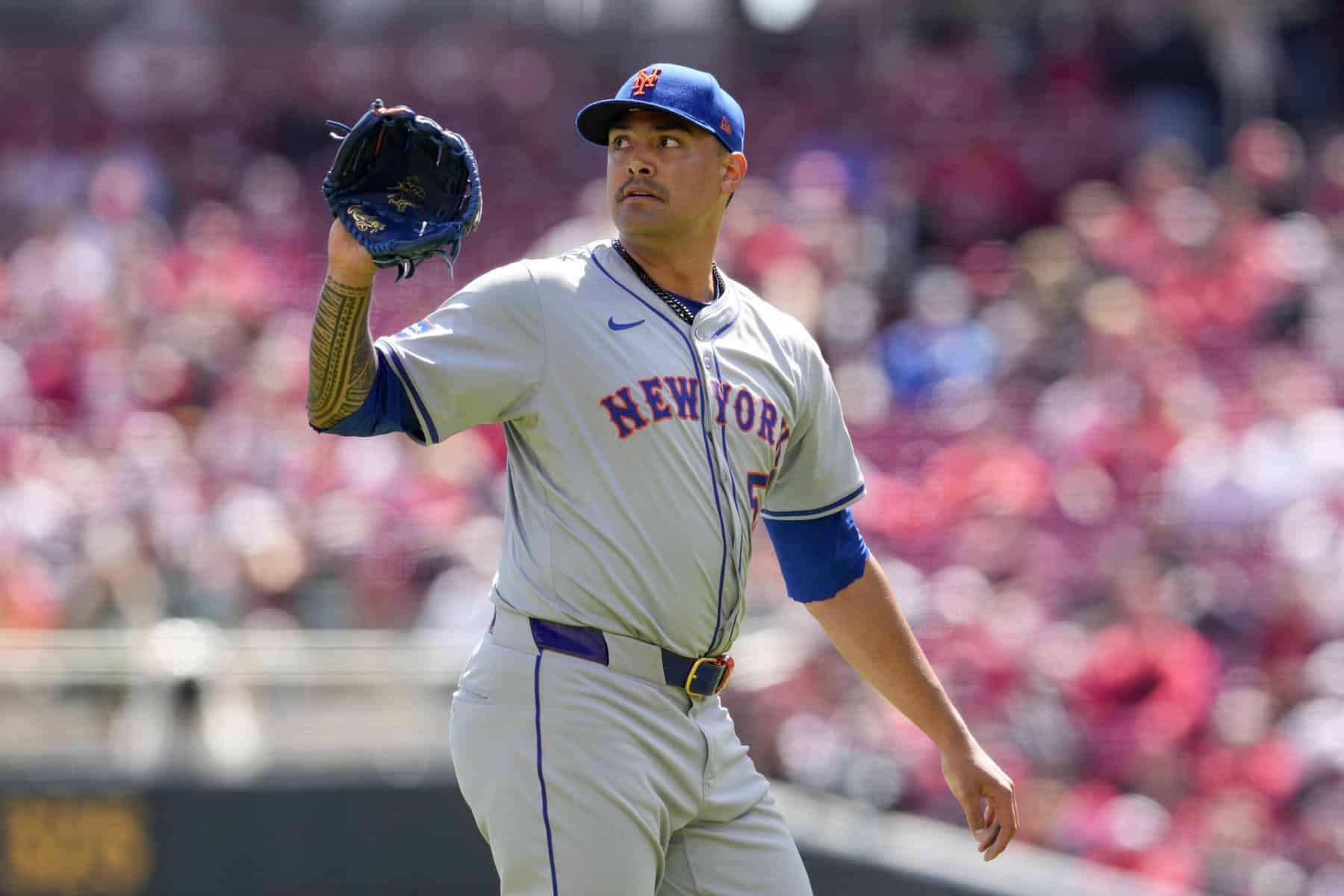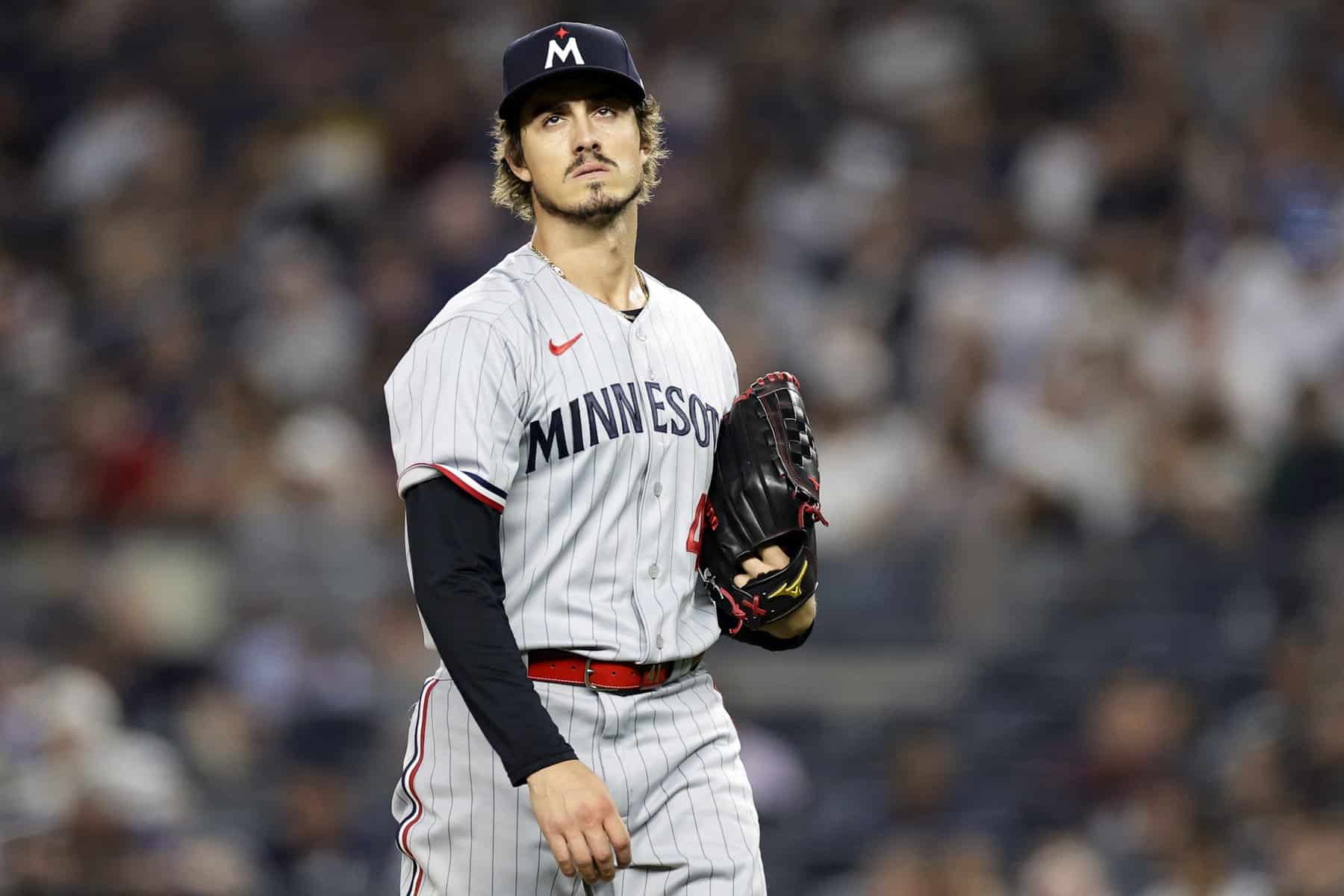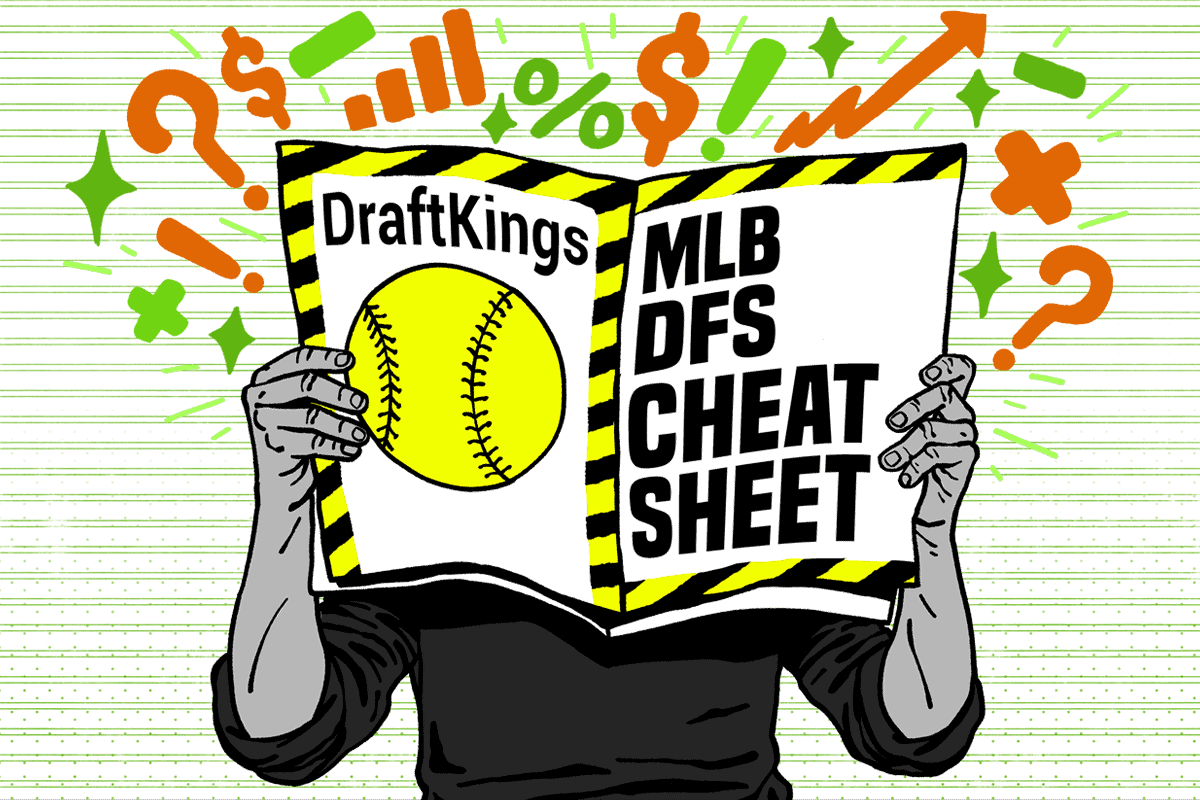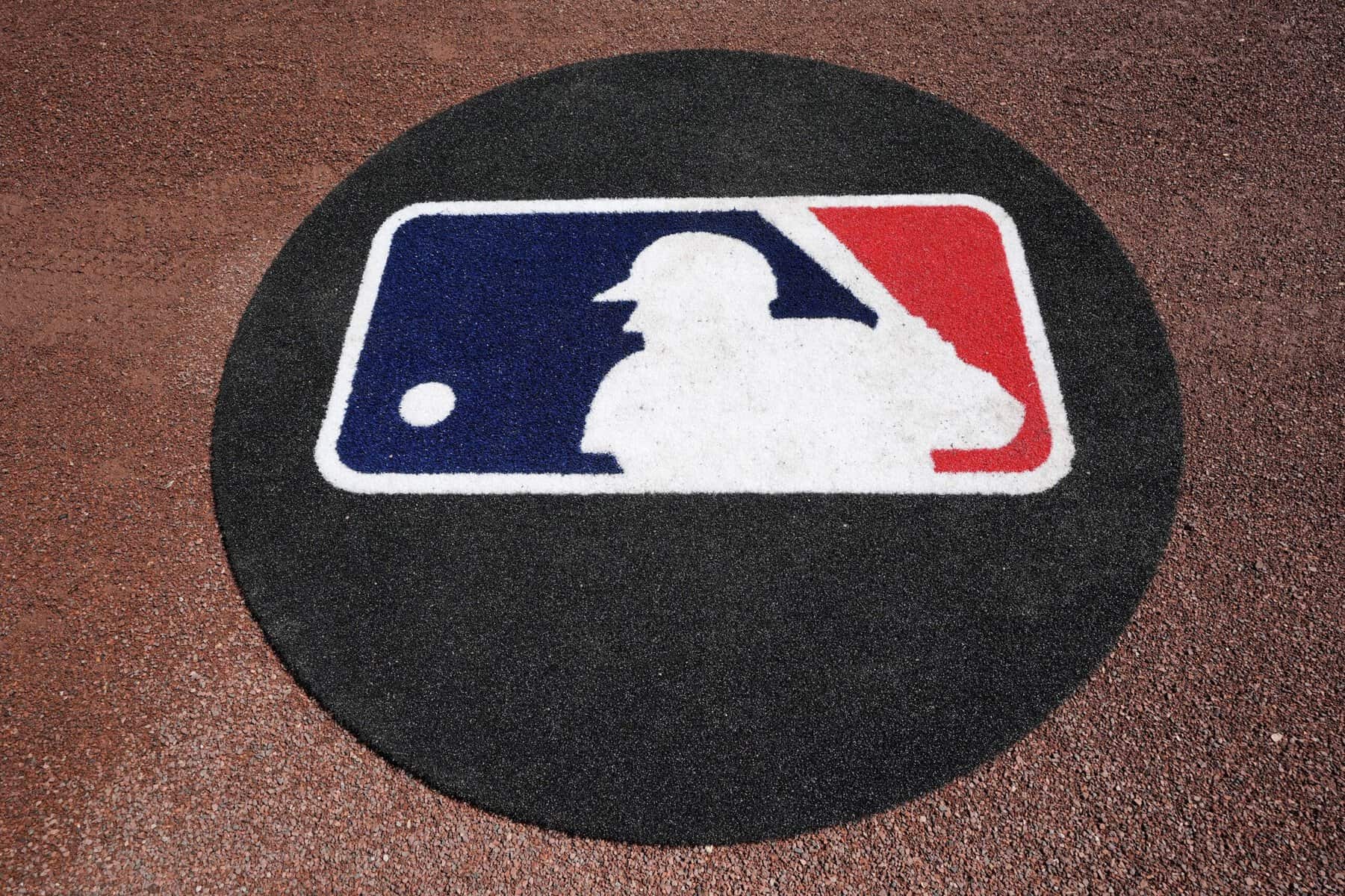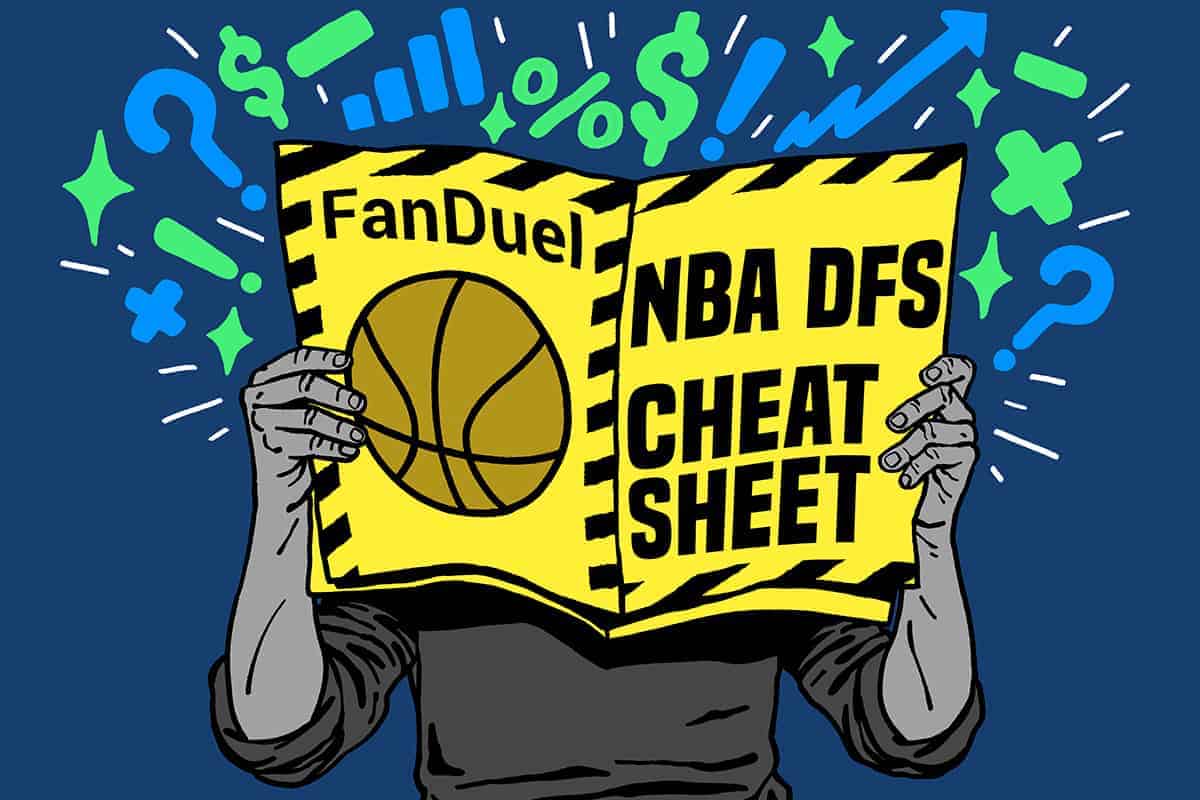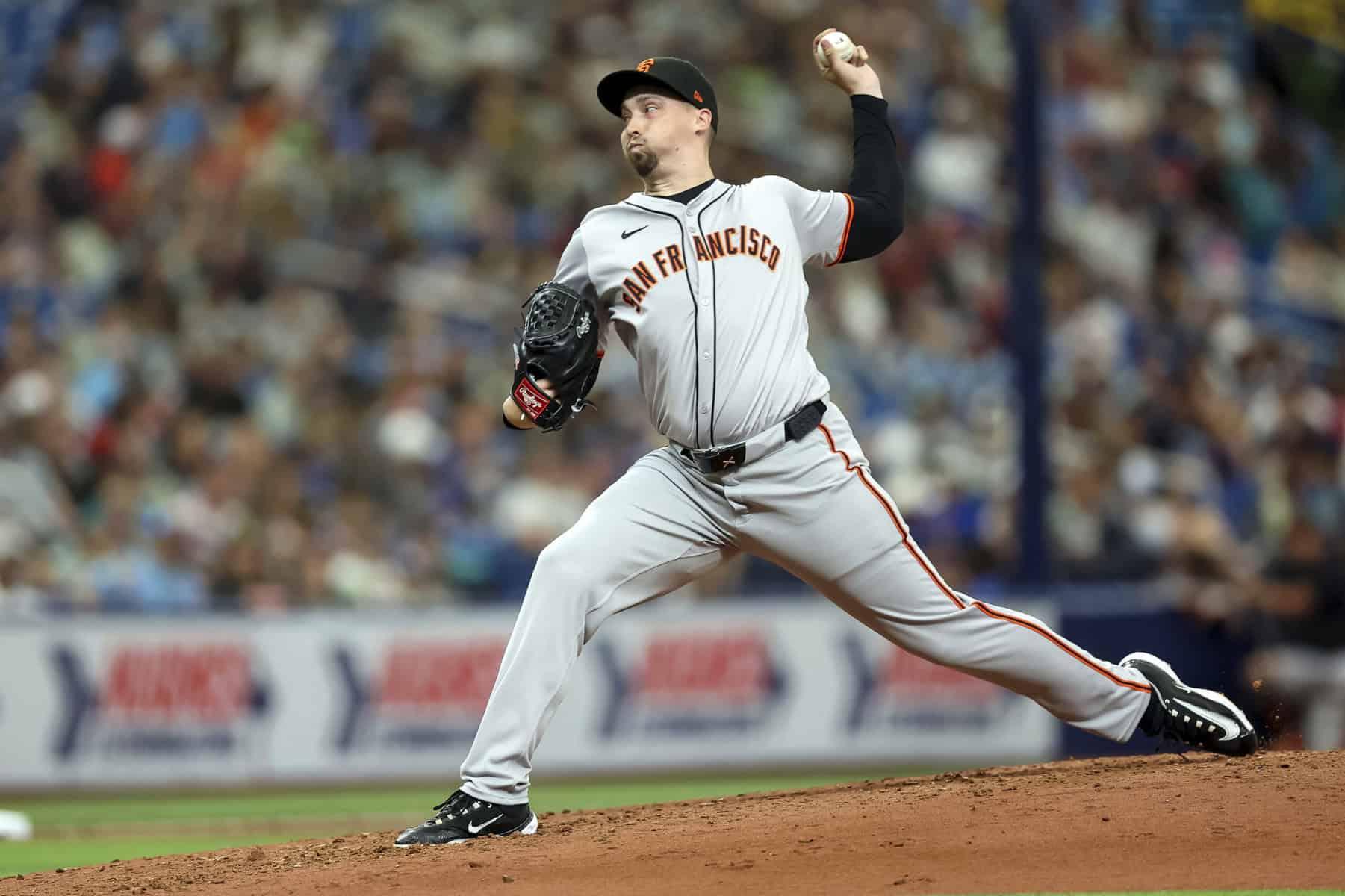Welcome to the MLB DFS Cram Session Day 3. We’re going to use our time on the last no-baseball day of this bizarre summer to take a look at MLB pitchers and see what has changed and who looks good for MLB DFS this season. Since pitchers work a bit differently than offenses do, in terms of needing to know every player in the lineup, I thought the best approach would be to create some tiers and look at a few sample pitchers within each while trying to gauge where they will fall for DFS pricing and popularity at the start of the season. If I’m being entirely honest I also couldn’t see creating another 60-something roster images.
1/2 OFF PROMO CODES
Sports are back and we’re giving you your first month of Awesemo+ half-off when you use promo code RESTART at checkout. That’s only $45 for a month of Awesemo’s leading DFS projections, tools and content for NBA, MLB, PGA and more! Celebrate the return of sports with this great deal, you won’t find a better value anywhere else. This offer is valid through Aug. 3.
Don’t forget to check out all the great info we have on the site for Opening Day, including Awesemo’s MLB DFS projections, top stacks and ownership projections. One of the new pieces I’m most excited to check out for this season is Awesemo’s Top Pitcher Probability tool. Similar to the Top Stacks this is going to be a great way to find hidden gems on every slate by comparing a pitcher’s probability in Awesemo’s sims of being the highest scoring option and their projected public popularity.
Pitcher Tiers for MLB DFS
We’re conducting this exercise with a degree of generality. Typically DFS tiers are going to be extremely price-driven, but that also follows a straight line through the talent pool until outlier or breakout seasons begin to emerge. With this, we can trust that most of our dominant aces like Max Scherzer will still be in that top tier of both talent and MLB DFS pricing through the season. The middle and bottom tiers are where we can expect to see more changes as guys move up and down the talent and pricing ladder.
Pitching is likely going to be a mess this season. With the short sprint schedule wins are going to be at an absolute premium and my expectation is that teams are going to lean heavily into their bullpens to protect leads in high-leverage situations. We’re going to see more 5-inning starts and early hooks than we’re used to with a lot of wins and peripheral stats landing on bullpen arms instead of starters. The most elite pitchers in the top tier will likely retain most of their value, but when we get down into the mid-range starters it’s anyone’s guess. Paying attention to how teams are utilizing their third, fourth and fifth starters is going to be a critical point in making pitching decisions this season.
The statistics included are 3-year numbers. I included innings, win totals and total batters faced as general reference points about the leash that a pitcher is given and to attempt to gauge the level of quality and what you might be able to expect on the wins crap-shoot. The stats we care more about are strikeout and walk rates, WHIP, xFIP and xFIP differential (ERA – xFIP).
Tier One – Expensive and Elite

Everyone in this tier is essentially an any start pitcher. Matchups and spots will vary to some degree but you can reliably plug these guys in every time you see the green check mark next to their name on your favorite site for MLB DFS. The only obstacle to using these starters in your lineup will be their price tag, typically they will be the most expensive options on the slate and your bats and stacks that fit with them will be more limited than lower tier arms. When all or most of these starters are on the same slate we need to dig and examine the specifics of each pitcher’s matchup. The arms in this tier are absolutely the best in the game.
Gerrit Cole has dominated for the last two seasons in Houston; the starter earned the gigantic contract the Yankees lavished on him partially by posting outrageous strikeout rates of 34.5% and 39.9% the last two seasons. There are some rumblings that Cole could struggle slightly with making his home starts in Yankee Stadium, but that doesn’t truly track to park factors. Over the last three seasons the Astros home park has actually been slightly better for home runs than the ballpark in the Bronx. Cole is an every start pitcher and is being taken in the first round of a lot of re-draft season-long leagues. He should be in-line for the win and quality start (where available) bonus every time he pitches, given his quality and the team he plays for.
Max Scherzer has been one of the elite pitchers of his generation. The ace was dominant despite struggling with a few nagging injuries last season, most of which were a result of some bad luck more than anything lingering or structural, there’s no reason to avoid him in MLB DFS even when he’s the most expensive pitcher on the slate by far. The three-time Cy Young Award winner is part of one of the best rotations in baseball and the Nationals should have him in the game for the win bonus every time out. The strikeout numbers are elite and Scherzer has posted a nearly K-BB% between 27 and 30.5% each of the last three seasons.
Walker Buehler has stepped into the shoes of Clayton Kershaw at the top of the Dodgers rotation. The kid was immediately elite upon his arrival midway through 2018 and continued to dominate through his first full season. The Dodgers have been careful with their precious 25-year-old during the shortened training camp, but he says he is good to go for a full workload going into the season. The starter had Tommy John surgery in 2015 and there are no concerns over injury, but care and management are always warranted here. Buehler displayed his potential for further growth in improving his already elite strikeout and walk rates in his second year and should be set to dominate through 2020. The Dodgers excellent bullpen and workload management are the only threats to his ability to get the win and quality start bonuses for MLB DFS players every time out, he plays for one of baseball’s best teams and they should provide plenty of run support.
The only thing that could get in the way of Jacob deGrom and Justin Verlander continuing their elite success are injury and age respectively. DeGrom has been dealing with a back issue throughout camp but is expected to be fine. Verlander is halfway through his age-37 year, though the stuff remains elite and his numbers have held up just fine in recent seasons after that odd blip before coming to Houston. Both pitchers play for teams that should be competitive and in the playoff hunt all season, putting them in line for the win bonus in every start.
Tier Two – Mixed Bag of Aces
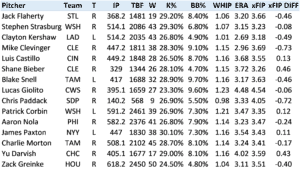
Tier Two is an interesting group of starters and possibly the most important for MLB DFS. This group is made up of arms that are generally elite for both baseball and DFS purposes but who all, for varying reasons, fall slightly below the absolute pinnacle of the sport. While they typically reside at the higher end of salaries on both sites, these are the guys where we see a lot of price fluctuation based on performance. This is also the tier where you can typically find an under-owned ace on large early-season slates that feature most of the team’s top starter.
Jack Flaherty is the name from this list that I was most tempted to include in Tier One. Flaherty has been elite in his two MLB seasons and has shown steady growth along the way. Flaherty’s strikeout rate was elite the moment he arrived and it remained consistent from year one through his sophomore season in 2019. The improvement in walk rate from 9.6% in his first full season to 7.1% in 2019 is noteworthy, as is the fact that Flaherty pitched to a 1.00 earned run average while holding opposing hitters to a .142 average and striking out 124 hitters in 99 innings over his last 15 starts in 2019. During that stretch Flaherty averaged 28.5 DraftKings and 47.3 FanDuel points per start. He is an elite arm with additional room for growth and I wouldn’t be at all surprised to see him truly join Tier One through 2020.
After arriving to great hype in 2010, Stephen Strasburg has been just outside the top tier of starters for his entire career. He is absolutely one of the best pitchers in the game any time he takes the mound but he’s simultaneously not the best pitcher in his own team’s rotation. Strasburg has produced an superb 29.1% strikeout rate for his 10-year career. After a minor blip that can be mostly attributed to an increased BABIP against during 2018, Strasburg’s put up a career best 1.04 WHIP in 2019, which was more in-line with his career average 1.09 than the 1.20 we saw in 2018. Strasburg is a top option any night he goes, but he’s a guy you can sometimes pick off at good value or ownership.
Clayton Kershaw has had some of the shine come off in recent years with his propensity for taking minor bumps that put him on the shelf for starts here and there or limit his innings. The reputation sometimes pushes his ownership down when there are other strong options on an MLB DFS slate and he’s absolutely someone you should pounce on in that situation. The three-time Cy Young Award winner’s ratio stats suffered slightly from giving up more home runs than usual in 2019. Homers are a stat with a ton of variance to it – this is what xFIP tries to eliminate from FIP – and Kershaw’s 1.41 HR/9 last season was an extreme outlier for his career. At the same time, Kershaw’s strikeout rate in 2019 trended back toward his career average of 27.5%, the starter posted a 26.8% mark a year after falling all the way to 23.8% in 2018. Kershaw averaged 24.7 DraftKings and 46.0 FanDuel points per game over his last 10 starts in 2019.
Finally delivering on his massive potential in his second full season, Lucas Giolito showed truly elite ability in his breakout 2019 campaign. The 26-year-old former super-prospect made gargantuan improvements in nearly every aspect of the game in 2019, essentially doubling the strikeout rate he had posted the season before, coming in at 32.3% over his 29 starts. At the same time he improved his K-BB rate by a factor of six, going from 4.5% in 2018 to an elite 24.8% last season while decreasing his walk rate from 11.6% to 8.1%. The White Sox are an exciting up and coming team and Giolito is their ace, from Opening Day on this is a pitcher you should closely monitor for price and popularity. When the scenario looks right smash the spot. He’s also someone you can reliably eat some chalk with when necessary.
Chris Paddack was the first of the Padres elite pitching prospects to arrive in the majors and he’s clearing a path in rapidly becoming one of the best starters in the game. Paddack’s rookie year did include a few bumps late in the season, three starts in his last 10 included giving up more than four runs without getting out of the fifth inning. Despite that, the numbers look excellent for the season and we should expect growth in his second year. Paddack has demonstrated elite ability to limit walks during his minor league career and it translated to the majors, the rookie walked just 5.5% of hitters while striking out 26.9%. The Padres should compete for the playoffs this season and they’re another of the league’s up and coming teams. The only concern with starting Paddack on a day he has both a high price tag and excessive popularity is probably the Padres absolutely elite bullpen. The team has demonstrated a willingness to go to the pen early and often, and if they’re in the hunt in this sprint of a season Paddack may miss out on some win and quality start opportunities due to the quick hook.
Phillies ace Aaron Nola is another starter that you can often get at a bit of a price and popularity discount. Nola took a small step backward in his second season which pushes him down the tier a bit. Nola’s minor struggles in his third full season are largely attributable to an outlier HR/9 of 1.20 after an average of 0.83 in his 80 starts over three seasons prior. Nola’s walk rate also increased in 2019, going all the way up to 9.4% after averaging 6.5% for his first four seasons. There is plenty to like with Nola every time out and I fully expect him to return to form. This is another high-end starter to keep an eye on in the first few days of MLB DFS tournaments, if the public isn’t enthusiastic I’ll be buying.
Charlie Morton had a career year at age 35 last season and is the person in this tier that I trust the least. Morton was a decent but not great starter for most of his career before finding himself when he was with the Astros and their advanced-minded pitching coaches. Morton became the spin-rate poster boy during his time in Houston, taking his strikeout rate from a career mark in the mid-to-high teens and turning it into a 27.65% average K% in his two seasons. by improving his spin rate to 2,936 rpm. The league average spin rate is 2,300 rpm and Morton had been below that for his career, so he clearly picked up a specific repeatable technique. This improvement continued through last year with the Rays, who have advanced thinking of their own, and Morton dialed it up even further with a 30.4% strikeout rate. A reduction in walks and a career best 1.08 WHIP supported the late-career breakout, but is it asking a lot for a repeat performance? Morton is heading toward the back-end of 36, his birthday is in November, and he showed signs of flagging late in the season last year. He’s still someone to go to with regularity, but when there are other options from this tier available Morton isn’t at the top of my list.
Tier Three –
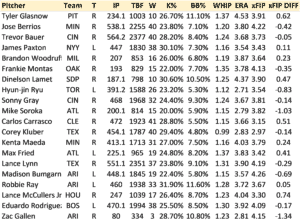
This tier is made up of name-brand pitchers who have either slipped slightly from their once lofty perches or are a bit shaky in one or two areas of the game that make their starts a bit more unpredictable. Roller coaster rides like Robbie Ray land toward the bottom of this tier, any one of these guys can give you a complete game shutout or major strikeout performance, but every now and then you’ll get that clunker performance and won’t have to check scores after 8 P.M.
Tyler Glasnow is a major buy-low candidate in a lot of season-long write-ups. Glasnow was lights out in his return to baseball at the end of 2019, following a major surgical procedure to repair nerve damage in his wrist that cost him most of the season. The big right-hander has long intrigued prospect watchers with his dazzling ability to strike hitters out. The 12-game stint in 2019 was the first time we’ve seen him truly harness his abilities, however, but there is a good chance we’re seeing repeatable growth, and Glasnow should benefit from the Rays’ advanced pitching department. Glasnow was able to focus his abilities for 60 innings last season, posting a huge 33.0% strikeout rate while effectively cutting his walk rate in half at just 6.1%. If Glasnow can keep up anything like this performance he will quickly see price increases in MLB DFS while becoming one of the game’s elite starters.
The Twins bats went bananas last year hitting a record number of team home runs in support of their pitching staff. The big bats overshadowed another solid year from the Twins top starter Jose Berrios. The 26-year-old would see a big jump if he could wrangle just a few more percentage points in his strikeout rate. His 23.1% career rate is just OK for this level of starter and he allows more opportunities than you’d like to see for where his price lands on a lot of slates. The 1.19 WHIP over the last three seasons is similarly fine but not great for this level. Still, there’s a lot to like in Berrios and potential for more than we’ve seen so far. The Twins will have him in line for the win and quality start bonus most nights so there’s plenty of reason to plug him in when price and popularity are appropriate.
In his own mind, Trevor Bauer is the planet’s greatest pitcher. To the baseball observer he seems more like a habitual tinkerer who is never quite satisfied and might create his own problems. Bauer’s arsenal includes an absurd number of pitches, but he mostly relies on a four-seam fastball and mix of a slider, curveball and cutter in varying degrees of usage. Bauer excelled in 2018 with Cleveland in his one truly standout year but has been mostly hype in most of the other seasons we’ve seen. In the small sample after arriving in Cincinnati last year he was truly disappointing in 10 starts in the senior circuit, posting a 6.39 ERA and ugly 1.35 WHIP, though he did maintain a roughly 27% strikeout rate and he had been significantly better – though still not elite – in his 24 starts in Cleveland before getting traded. Bauer is a difficult guy to trust in MLB DFS but in the right spot he has tournament winning upside. The roller coaster ride at times turns people off and this is a pitcher you can pick off in spots where his ownership projections trend below his probability of success in Awesemo’s top pitchers tool.
James Paxton was a big beneficiary from the delayed start to the season in terms of his ability to contribute. Originally slated to be out until around now in the full season after undergoing surgery in February. Paxton came into New York with some injury concerns as a big free agent signing last season but was able to make 29 starts and post basically the numbers that the Yankees were expecting. The lefty’s big strikeout rate has hovered between 28 and 30% through the last three seasons and was on that mark in 2019, though a second straight year with an increased HR/9 causes a bit of concern when half of his appearances come in hitter-friendly Yankee Stadium. Paxton is a high-end starter on one of the best teams in baseball, putting him in-line for the win bonus on most slates. Yankees manager Aaron Boone’s relatively quick hook with starters got Paxton a few times last season before he could secure the quality start bonus for FanDuel players, but he makes an excellent option when he’s carrying a good price. He also seems like someone that MLB DFS owners aren’t always eager to roster, which is always something that puts a guy of this caliber on my target list.
Dinelson Lamet could easily let me down on this rating, but if he pulls it all together now that he’s further removed from his injury and rehabilitation he could easily be one of the league’s best starters. Lamet is already one of the best strikeout pitchers in the game with his electric arsenal of pitches the injury-plagued 28-year-old has a strikeout rate in excess of 30% over the 35 MLB starts he’s been able to make since the start of the 2017 season. In his 14 starts after coming back from missing all of 2018 following Tommy John surgery Lamet posted the season’s highest strikeout total with 14 in a game to go along with three other starts in which he struck out more than 10 hitters. He showed minor improvement in lowering his walk rate from an unsustainable 11.1% in 2017 to 9.6%, and if he can bring that mark down just a couple additional percentage points he should truly shine. Lamet is a name causal MLB DFS players may not remember going into the early slates this year which hopefully will put him firmly in play for us. He’s someone I’m going to be over the field on a lot this year.
There’s a lot of excitement in two countries that Hyun-jin Ryu won’t be pitching in this season. The South Korean native has a major following back home, which came up quite a few times during KBO coverage the last few months. Everyone in South Korea and Toronto was excited to see what the move to the Blue Jays and their young up and coming roster would mean for Ryu, but now the Blue Jays won’t even be playing their home games in Toronto. The team announced on Wednesday that they reached an agreement to play home games in Pittsburgh’s PNC Park. This could actually be good news for Ryu in the long run, PNC plays somewhat better as a pitcher’s park and could work to his advantage (Update: this news may have been announced too soon, later reporting Wednesday afternoon indicates a fluid situation. Pennsylvania has yet to grant the team permission and they are considering options that include playing “home” games in road stadiums or possibly playing in Baltimore. Stay tuned). Ryu has been outstanding in his last 48 starts, dating back to the beginning of 2018, despite missing a major chunk of the 2018 season after tearing his groin. Ryu has been an injury prone starter through his career, but for DFS purposes we really only care about him when he’s on the mound, if he misses starts he’s just a non-factor. Ryu has sustained a 1.01 WHIP and an excellent sub-five walk rate over that 44-start stretch and should remain a solid option for MLB DFS given that people seem to avoid starting him with regularity.
Max Fried is a young lefty starter for the Braves who I expect to take the next step this season. Fried was electric but wild in a cup of coffee with the Braves in 2018, but he stuck with the rotation for 30 starts in an excellent 2019 campaign. The earned run average of 4.02 may turn-off the casual observer but there is plenty of quality to get excited about in his 3.32 xFIP. Combining that under the radar performance with the fact that Fried already cut his walk rate from 14.1% in those 14 appearances in 2018 to just 6.7% last season and you’ve got a breakout pitcher in waiting. Fried has more to give in the strikeouts department as well, last year his rate was down slightly to 24.6% but he cracked 30% in 2018 and has reached that mark several times in the minors. As a member of the Braves’ excellent young rotation this is a pitcher on a team on the upswing, he should be a mainstay play for MLB DFS this year and beyond. Add in the fact that Fried frequently threw with lower popularity than he should have had in 2019 and this is a guy I want to be over the field on until everyone has caught up.
Maybe I’m just being stubborn, but I still refuse to believe that Madison Bumgarner is shot at just age 30. The three-time World Series winner and four-time All Star has suffered a string of stupid unpredictable non-structural injuries including missing major portions of 2017 and 2018 after having his hand broken by a line drive and suffering rib injuries in a four-wheeler crash that notably did not happen on a baseball field. In a full season in 2019, Bumgarner’s strikeout and walk rates were relatively in-line with his career numbers, though his xFIP was increased to a concerning 4.31. The former ace seems to be struggling slightly with inducing soft contact, posting a rate around 5 percentage points lower than he was averaging at his apex. Most of that contact moved directly from soft to hard as well, making things worse. If Bumgarner can figure things out we could see a return to form and a sneaky MLB DFS option. The move to Chase Field from the pitcher’s paradise that is Oracle Park isn’t working in his favor however. This is someone you can safely file in the wait and see category if you’re risk-averse, although it often pays to be early on a play like this.
Tier Four – Best of the Rest
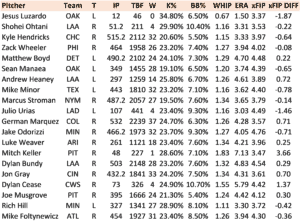
Tier Four represents the big mixed bag of second and third starters that make up the middle-class options of MLB DFS. These are the guys I usually don’t like to drop below unless there is a very intriguing price on someone I consider underrated. After the first or second time through rotations we should see enough staggering of starts that some collection of reasonable options from tiers three and four should be available on any given slate.
Jesus Luzardo will be a Tier Two pitcher on this list next year, write it down. One of the best up and coming pitching prospects in the league, Luzardo arrived late in 2019 to throw 12 effectively dominant innings out of the Oakland bullpen. In the extremely small sample the kid put up a 34.8% strikeout rate to just 6.8% walks. He’s not an unknown commodity as he’ll appear on plenty of season-long MLB tout lists, but he still might go under-owned by the MLB DFS public until he draws more attention to himself with performance, don’t be behind the curve.
I am very concerned about Shohei Ohtani’s ability to stay healthy and on the mound for the Angels. With a talent like his at the plate it’s a major risk to stick him back in the rotation after a year and a half off from pitching to rehab his latest injury. This is a guy who is excellent on the mound when healthy, but pitching has clearly cost him time in his career. If he’s able to make his full complement of starts, Ohtani has the ability to dominate. DFS players won’t have to suffer the dual-role problem with Ohtani that season-long owners deal with, his once a week start rate doesn’t make him viable as a pitcher and losing a game a week at the plate limits his appeal as a hitter in that format in a 60-game season. Depending on his price and his matchup this is a pitcher you can get to, but I get the feeling he’s going to be more popular than he deserves early on. In his 10 starts in 2018 before Tommy John surgery Ohtani posted an electric 29.9% strikeout rate but also walked too many hitters at 10.4%. It will be interesting to watch the return to form and the degree to which the Angels limit his innings to protect their asset.
Sean Manaea was very good and went mostly unnoticed in DFS in his limited return to the Oakland rotation at the end of 2019. In his five starts Manaea put up a 27.5% strikeout rate with a 21.1% K-BB rate. The lefty soft-tosser floats in the 88-90 mph range with his four-seam fastball but has a wipe-out slider that dives off the plane with momentum and a killer sinking change-up that baffles hitters and generates swing and miss strikes. Manaea slots into a dynamic A’s rotation alongside Frankie Montas and Luzardo which should form a new three-headed monster in the Oakland rotation. If he’s in the right spot for price and ownership Manaea is someone I’ll always consider.
The Mets’ Marcus Stroman seems happy to be pitching in New York after wanting out of Toronto badly for about a year and a half. Stroman pitched well in his 11 games with the Mets at the end of last year and big things are expected from the 5’8′ starter this season. In his stint in Queens the right-hander posted an average of 30 FanDuel points per game, which was solid value for his pricing at the time last season. An improved career-high strikeout rate across all of 2019 played a part in the appeal for the Mets to pull the trigger on bringing him to town and he rewarded them by bumping it slightly further up in his New York starts. There is upside here and anyone who has watched Stroman will rave about his stuff in the eyeball test. For now the numbers say he is who we think he is however, which means we only want to look this way in strong match-ups. Stroman typically makes a quality SP2 mid-price option on big slates where he won’t draw too much attention but becomes difficult to roster in that capacity if his price moves up.
Luke Weaver is a guy who MLB DFS players saw deliver several times at low prices early in 2019 before a UCL strain wrecked most of his season. Weaver was excellent in his 12 starts, posting a 3.07 FIP, 26.5% strikeout rate and a 5.4% walk rate. He limited home runs somewhat dramatically during that stretch, down to 0.84 HR/9 from the 1.25 he posted over more innings in 2018, that could be variance or quality, there’s just not a large enough sample to know for sure. This is an under-valued asset for MLB DFS for as long as he’s able to stay on the mound. The Diamondbacks have already announced their intent to treat him with kid gloves, giving him a few weeks with an extra day off by employing a sixth starter, but when he goes I’ll be looking his way.
Mitch Keller, Dylan Cease, Dylan Bundy and Jon Gray all make this tier based on their talent more than the numbers they have put up so far in their careers. These are pitchers with special arms seeing interesting opportunities. There are breakout years primed here but it might be asking a lot in a shortened season where guys will just be rounding into form in time for their last game of the year. Still, I would not be surprised at all to see one or more of these starters make a leap this season. My money is on Dylan Bundy.
More options will surely emerge through the season and we’re going to see bullpens play a major role this year, things are going to be very interesting on the pitching front. Perhaps more than ever, this season make sure you’re checking back with the site on a daily basis for all the latest news and current analysis of the day’s options.
Related MLB DFS Content
- Spotlight Hitters
- MLB Cram Session Part 1
- MLB Cram Session Part 2
- MLB Cram Session Part 3
- Top MLB DFS Stacks, quick hits for Opening Day
- The MLB Strategy Show
- The MLB DFS Hub
Follow us on all of our social channels! Check out our Twitter, Facebook, Instagram and YouTube for more great Awesemo content.

